How to Organize Emails in Outlook
Microsoft provides a number of features for organizing emails in Outlook and keeping your mailbox clutter-free moving forward.
With the following list of Outlook email organization tips, you can use just one or two of them, or opt for a combination of several to organize emails effectively.
1. Perform an Initial Cleanup
Before we show you the best ways to organize Outlook emails, consider an initial cleanup of your inbox to remove subscriptions and spam. You can unsubscribe from newsletters and promotional messages you no longer want and mark emails that are spam to automatically send them to the Junk folder.
You’ll then have a tidy inbox, ready for your Outlook email organization to begin!
Unsubscribe
To unsubscribe from emails in Outlook on the web or your desktop:
- Select or open an email you no longer want to receive.
- Click Unsubscribe at the top.
- Choose OK in the pop-up window to confirm.
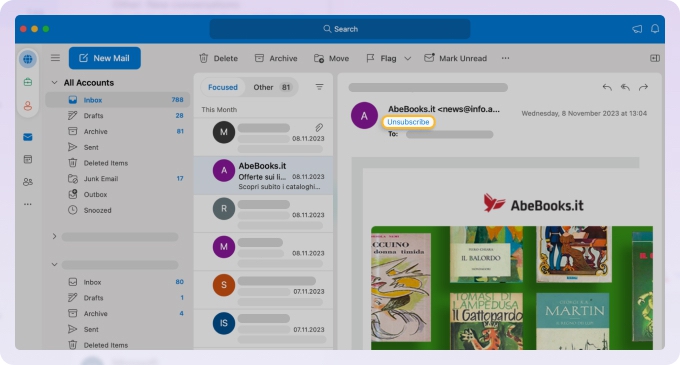
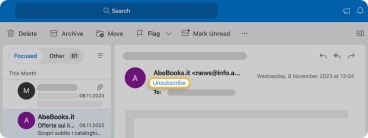
Continue this process for additional emails you want to unsubscribe from in Outlook.
📌 Tip: With Unsubscriber in Clean Email, you can unsubscribe from multiple messages at once!
Mark Spam
To mark a message as spam in Outlook on the web, select the email and either right-click and move to Report or open the Report menu in the toolbar. Then, choose Report Junk.

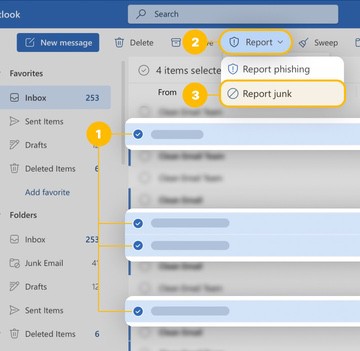
To mark a message as spam in the Outlook desktop version, select the email and either right-click and move to Junk or open the Junk menu on the Home tab. Then, choose Block Sender.
2. Take Advantage of the Focused Inbox
The Focused inbox in Outlook provides you with a simple way to see your most important emails separately. Less significant messages remain out of view but are still easy to access using the Other tab.
To turn on the Focused Inbox on the web:
- Select View at the top.
- Pick View settings in the top toolbar.
- In the pop-up window, you’ll see Layout all the way to the right. Mark the option for Sort messages into Focused and Other.
- Click Save at the bottom and use the X on the top right to close the window.

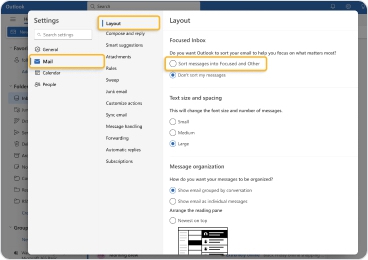
To turn on the Focused Inbox on your desktop, go to the View tab and click Show Focused Inbox.


You can then switch between the tabs for Focused and Other at the top of your inbox.
3. Create Outlook Folders
To keep messages neat and tidy in Outlook, you can move them into folders. This allows you to simply open a folder to view the emails within it. Plus, if you set up inbox rules, you can automatically move messages into folders, which we’ll walk through in the next section.
While you can name and organize Outlook folders any way you like, you might consider creating them for an email triage scenario.
Consider folders such as:
- Important: Emails requiring an immediate action or response.
- Information: Emails that are informational only, requiring no action or response.
- Investigate: Emails requiring time to review or research before acting or responding.
With this method, you can sort emails into folders as soon as they arrive and then view the folders as needed.
To create a folder in Outlook on the web:
- Expand Folders in the left-hand menu.
- At the bottom of the folder list, choose Create new folder.
- Enter the folder name and click Save.
To create a folder in Outlook on your desktop:
- Make sure the navigation pane is open on the left.
- For a main folder, right-click your email account and choose New Folder.
- For a subfolder, right-click a main folder and choose New Folder.
- Enter the folder name and press Enter.
4. Set Up Inbox Rules
As mentioned above, you can create inbox rules to automatically manage and move incoming messages. This is probably one of the best ways to organize emails in Outlook because you simply set it and forget it.
You can set up a rule to move an email, flag a message, or assign a category, and let Outlook take care of the messages moving forward. Let’s look at an example.
To move an email to a folder based on the sender in Outlook on the web:
- Open the email and click More options (three dots) on the top right of the message.
- Pick Rules → Create rule.
- Choose a folder to move the email to in the drop-down list. For other conditions and actions, select More options instead.
- Click OK to save the rule and optionally run it immediately.
To create that same rule using Outlook on your desktop:
- Right-click the email, move to Rules, and pick Always Move Messages From [sender].
- Choose the folder in the pop-up window and click OK to save the rule.
Outlook will immediately run the rule in your inbox and apply it to existing messages.
For more, check out our complete guide for setting up Outlook rules.
5. Assign Outlook Categories
Wondering how to manage emails in Outlook similarly to those in Gmail? Outlook provides Categories that are similar to Labels in Gmail. You can assign color-coded categories to messages that make them easy to spot.
Additionally, you can keep related emails marked until you act on them, such as short-term projects or billing statements. If using folders doesn’t work for you, this is a good alternative.
To quickly assign a category, right-click the email, move to Categorize, and choose a category in the pop-out menu.
To change the category labels from the default color names:
- Right-click an email, move to Categorize, and choose Manage Categories (web) or All Categories (desktop).
- When the list of Categories displays, do one of the following:
- On the web, select the Edit icon (pencil), enter the new name, and click Save.
- On the desktop, select the category and pick Rename. Enter the new name, press Enter, and click OK when you finish.
You’ll then see emails with their assigned categories in your inbox and can even sort by category if you like.
6. Use Flags for Follow-Up
If you want to remind yourself of an email that you need to follow up on, act on, or respond to, you can flag it in Outlook. This then allows you to choose a follow-up time and let Outlook remind you.
To flag an email for the current day, select the Flag button to the right of the email in the message list. On the web, you can also right-click and pick Flag.
To flag an email for a different day, select the message and do one of the following:
- On the web, open the Flag menu in the top toolbar, and choose the timeframe.
- On the desktop, right-click, move to Follow-Up, and choose the timeframe.
7. Consider an Email Organizer App for Outlook
One more way to take on Outlook email organization is with an app that provides robust features and more flexible tools.
Using Clean Email, you can perform many of the same Outlook email management actions including unsubscribing, marking spam, creating folders, and setting up rules. But you have more control with Clean Email’s features along with additional tools to keep your Outlook inbox organized and clutter-free.
How to Organize Outlook Email with Clean Email
Clean Email is a superb email organizer for Outlook with features that go beyond the basics. Not only can these tools save you time because they perform actions automatically but give you more control over the messages that you deem the most important.
Here’s how to organize Outlook email with just a few of Clean Email’s advanced features.
Smart Folders
If you like the folder method of organization, then you’ll love Clean Email’s Smart Folders. Using built-in filters, Clean Email sorts messages into premade folders automatically.
You’ll find Smart Folders for Online Shopping, Travel, Seasonal Deals, and more. You can then view all related emails in one spot without having to lift a finger to move them yourself.
- Expand Smart Folders in the menu on the left.
- Select a folder to view its contents.
- You can then simply read the emails or take action in bulk. You can delete, flag, archive, or perform other actions with messages using the arrow next to the Trash button on the right.
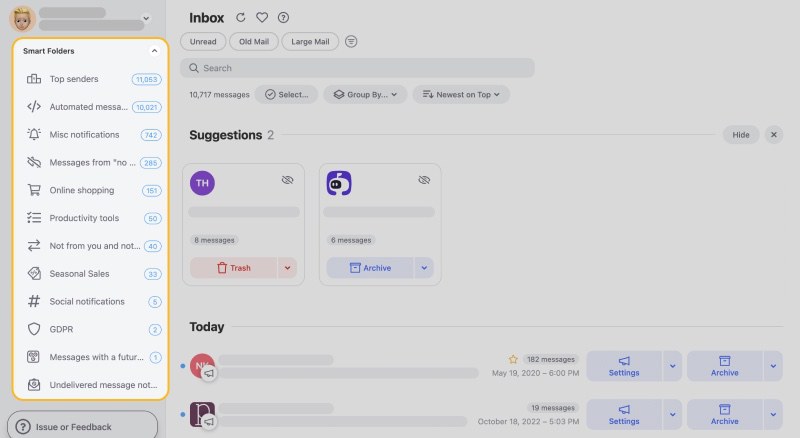
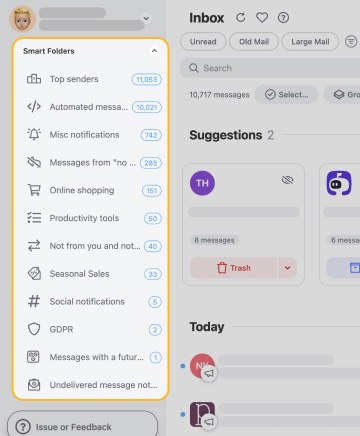

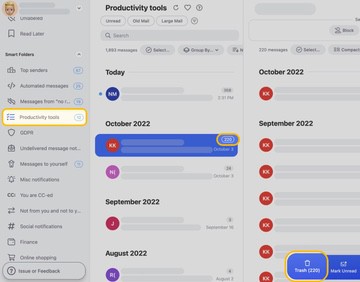
Keep Newest
Maybe you read through your emails but leave them sitting in your mailbox. This leads to a messy Inbox and risk of important messages getting lost in the clutter.
Using the Keep Newest feature in Clean Email, you can get rid of outdated messages by keeping only the newest ones at your fingertips.
- Head to your Inbox or All Mail using the menu on the left.
- Select a group of messages or the arrow next to the Trash button on the right of the group and choose Keep Newest.
- Click Confirm to keep the newest message and send the rest to the Trash.
Pinned Sender Lists
Another great way to organize Outlook emails in Clean Email is by using the Pinned folder. With it, you can set up lists of friends, family, and coworkers and then find messages from them all in a single folder.
- Open the drop-down box with your account name in the menu on the left and pick Preferences.
- Select the Pinned tab.
- Add email addresses or domains to the Pin messages from field, or choose Manage Friends list, Manage Family list, or Manage Coworkers list and enter their email addresses in the corresponding box.
- Turn on the toggle beneath the box.
You can then open the Pinned folder to see all messages from your preferred senders. Expand Mailbox in the left-hand menu and pick Pinned.
Manage Messages On-The-Go
Clean Email offers mobile apps for both Android and iPhone that provide the same features as the Clean Email web and desktop applications. This means you can do things like create rules and unsubscribe in bulk on your mobile device, which is something the Outlook mobile app lacks.
Want to perform a bit of Outlook email organization when you’re out for lunch or taking a quick coffee break? The Clean Email mobile app has you covered!
Conclusion
With these Outlook email organization tips, tricks, and features, you can make sure that important emails don’t get lost and enjoy a well-structured mailbox overall. And definitely consider Clean Email for finding messages faster, seeing related emails in one spot, and managing messages on-the-go.
Now that you know how to organize emails in Outlook, be sure to look at these email organization mistakes you should avoid.
How To Organize Email In Outlook - FAQs
What is the best way to organize emails in Outlook?
The best way to organize Outlook emails is by creating folders for different categories, using the Focused Inbox feature, archiving or deleting old emails, and using an email organizer for Outlook like the Clean Email app.
How do you categorize emails in Outlook?
To categorize emails in Outlook, select an email, click the "Categorize" button on the Home tab, and choose a color-coded category. You can manage and rename these categories via the "All Categories" option under the same Categorize dropdown.
How do you organize emails by subject in Outlook?
To organize emails in Outlook by subject, click on the view tab on the ribbon → select the message folder you want to sort by subject → select subject. In Clean Email, all you need to do is choose the folder (All Mail, Inbox, etc.) and choose "Group by subject" above the emails from this group.
How to organize Outlook inbox by date?
By default, Outlook emails are categorized by date. Newer messages are at the top, and older messages are at the bottom.
How do you prioritize emails in Outlook?
To prioritize emails, we recommend you use folders and subfolders to cart away important messages. This way, you can stay focused on only the emails that matter.
How do I declutter my Outlook email?
Start by unsubscribing from unnecessary newsletters and promotional emails, then use rules to automatically sort incoming messages into designated folders. Additionally, consider using the Clean Email app to manage and remove old or irrelevant emails efficiently.


